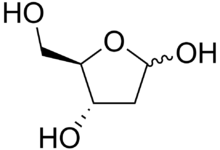Deoxyribose
deoxyribose, (< from English: des 'des' + oxygen, 'oxygen' + ribose, 'ribose') or more precisely 2-deoxyribose, is a deoxysugar derived from a monosaccharide with five carbon atoms (pentose, empirical formula C5H10O4), derived from ribose by loss of an oxygen atom in the hydroxyl of 2', and therefore does not respond to the general formula.
It is a colorless crystalline solid, quite soluble in water. In its furanose form (pentagonal ring) it forms part of the nucleotides that make up the chains of deoxyribonucleic acid (DNA).
Structure
Several isomers exist with the formula H-(C=O)-(CH2)-(CHOH)3-H, but in deoxyribose the hydroxyl groups They lie on the same side of the Fischer Projection. The term "2-deoxyribose" can equally refer to two enantiomers: the biologically important D-2-deoxyribose and its unusual mirror image L-2-deoxyribose. D-2-deoxyribose is a DNA nucleic acid precursor. 2-Deoxyribose is an aldopentose, that is, a monosaccharide with five carbon atoms and containing an aldehyde functional group.
In aqueous solution, deoxyribose consists primarily of a mixture of three structures: the linear form H-(C=O)-(CH2)-(CHOH)3-H and two variable cyclic forms, deoxyribofuranose, with a ring of four carbon atoms, and deoxyribopyranose, with a ring of five. The second form is the predominant one.
Biological importance
As a component of DNA, 2-deoxyribose derivatives play an important role in biology. The DNA (deoxyribonucleic acid) molecule, which is the main source of genetic information in life, consists of a long chain of deoxyribose-containing units called nucleotides, linked through phosphate groups. In standard nomenclature, a DNA nucleotide consists of a deoxyribose molecule with an organic base (usually adenine, thymine, guanine, or cytosine) attached to the 1' carbon. of sugar. The hydroxyl 5' of each deoxyribose unit is replaced by a phosphate (forming a nucleotide) that is attached to the 3' carbon. of the deoxyribose earlier in the chain.
The backbones of DNA and RNA are structurally similar, although RNA is single-stranded and is made of ribose instead of deoxyribose. The absence of the 2' in deoxyribose it is apparently responsible for the increased mechanical flexibility of DNA compared to RNA, which allows it to assume the double helix conformation, and also (in eukaryotes) to be tightly coiled within the small cell nucleus. Double helix DNA is generally much longer than RNA molecules.
Other important biological derivatives of deoxyribose include mono-, di-, and triphosphates, as well as 3'-5' cyclic monophosphates.
Biosynthesis
Deoxyribose is generated from ribose 5-phosphate by enzymes called ribonucleotide reductase. These enzymes catalyze the process known as deoxygenation.
History
It was discovered in 1929 by Phoebus Levene.
Contenido relacionado
Category: Vegetables
Raven (disambiguation)
Dna viruses

